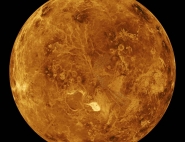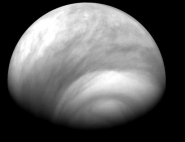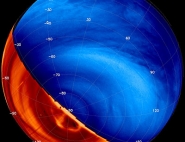Key milestones
2014 Events
12/16/2014: Venus Express goes gently into the night
Venus Express has ended its eight-year mission after far exceeding its planned life. The spacecraft exhausted its propellant during a series of thruster burns to raise its orbit following the low-altitude aerobraking earlier this year.
More information on ESA's website.
11/20/2014: ESA Science Programme Committee confirmed the support for the final phase of Venus Express operations during 2015
Venus Express is expected to burn up in Venus's atmosphere during 2015, completing its intensive survey of the cloud-shrouded planet.
More information on ESA's website.
07/28/2014: Venus Express: up above the clouds so high
ESA's Venus Express spacecraft has climbed to a new orbit following its daring aerobraking experiment, that saw the spacecraft surf in and out of the atmosphere, at altitudes typically between 131 km and 135 km, for a couple of minutes on each of its closest approaches to the planet. The spacecraft will now resume observations of this fascinating planet for at least a few more months.
The Venusian cloud tops during nearly a full orbit of ESA's Venus Express around the planet. The inset shows the corresponding position and relative speed of Venus Express as it approaches from its furthest distance of 66 000 km above the south pole, swooping down to 250 km above the north pole. Credits: ESA/MPS/DLR/IDA, M. Pérez-Ayúcar & C. Wilson
This orbit will slowly decay again under gravity, but with only a few kilograms of fuel at most now remaining further altitude-raising manoeuvres may not be possible. If no further corrections are made, Venus Express will probably reenter the atmosphere again in December, but this time for good, ending the mission.
In the meantime, having survived not only the aerobraking experiment but also the most recent orbit-raising manoeuvres, all of the science experiments will be reactivated, continuing their detailed study of Venus for at least a few more months.
More information on ESA's website.
05/16/2014: Venus Express gets ready to take the plunge
After eight years in orbit, ESA's Venus Express has completed routine science observations and is preparing for a daring plunge into the planet's hostile atmosphere. It has been orbiting Venus in an elliptical 24-hour loop that takes it from a distant 66 000 km over the south pole - affording incredible global views - to an altitude of around 250 km above the surface at the north pole, close to the top of the planet's atmosphere. The spacecraft is being prepared for one final mission: to make a controlled plunge deeper into the atmosphere than ever before attempted.
![]()
Visualisation of Venus Express during the aerobraking manoeuvre, which will see the spacecraft orbiting Venus at an altitude of around 130 km from 18 June to 11 July. © ESA-C. Carreau
This "experimental aerobraking" phase is planned for 18 June - 11 July, during which time some limited science measurements with the spacecraft's magnetic field, solar wind and atom analysing instruments will be possible. Also, temperature and pressure sensors will record the conditions that the spacecraft is experiencing. It is possible that the remaining fuel in Venus Express will be exhausted during this phase or that the spacecraft does not survive these risky operations. But if the spacecraft is still healthy afterwards, its orbit will be raised again and limited operations will continue for several more months, fuel permitting. Eventually, however, the spacecraft will plunge back into the atmosphere and the mission will end.
More information on ESA's website.
01/13/2014: Venus mountains create wave trains in clouds
The planet Venus is blanketed by high-level clouds. At visible wavelengths, individual cloud features are difficult to see, but observations made by instruments on ESA's Venus Express orbiter have revealed many small-scale wave trains. Analysis shows that the waves are mostly found at high northern latitudes, particularly above Ishtar Terra, a continent-sized region that includes the highest mountains on the planet.
![]()
VMC images of wave trains on Venus
Copyright: ESA/Venus Express/VMC/A. Piccialli et al., 2014
More information on ESA's website.
Read also the publication "High latitude gravity waves at the Venus cloud tops as observed by the Venus Monitoring Camera on board Venus Express" printed in Icarus
2012 events
02/13/2012: VIRTIS shows that Venus rotation is slower than previously measured
ESA's Venus Express spacecraft has discovered that our cloud-covered neighbour spins a little slower than previously measured. Peering through the dense atmosphere in the infrared, the orbiter found surface features were not quite where they should be.
Using the VIRTIS instrument at infrared wavelengths to penetrate the thick cloud cover, scientists studied surface features and discovered that some were displaced by up to 20 km from where they should be given the accepted rotation rate as measured by NASA's Magellan orbiter in the early 1990s.
More information on ESA's website
2011 events
10/06/2011: Tenuous ozone layer discovered in Venus' atmosphere
Using observations of Venus performed with an instrument on ESA's Venus Express scientists have detected, for the first time, a tenuous layer of ozone in this planet's atmosphere. Located at an altitude of about 100 km, the layer is a thousand times less dense than the one found, at a lower altitude, in the Earth's stratosphere, but both are dominated by very similar chemical reactions. The discovery poses new challenges to the characterisation of planetary atmospheres, especially in the quest for biomarkers on extrasolar planets.
More information on ESA's website
04/07/2011: The shape-shifting southern vortex of Venus
New analysis of images taken by ESA's Venus Express orbiter has revealed surprising details about the remarkable, shape-shifting collar of clouds that swirls around the planet's South Pole. This fast-moving feature is all the more surprising since its centre of rotation is typically offset from the geographical pole. The results of this study are published online in Science Express.
More information on ESA's website
2010 events
11/30/2010: Venus holds warning for Earth
A mysterious high-altitude layer of sulphur dioxide discovered by ESA's Venus Express has been explained. As well as telling us more about Venus, it could be a warning against injecting our atmosphere with sulphur droplets to mitigate climate change.
More information on ESA's website
11/19/2010: ESA announced that the mission was again extended, pushing back the mission end date to the end of December 2014.
11/09/2010: Sulfur dioxide in Venus high atmosphere: a key to fight the global warming on Earth?
More information on INSU's website (in French) or
on CNES' website (in French)
10/07/2010: VENUS EXPRESS found that the polar atmosphere of Venus is thinner than expected by flying through it.
More information on ESA's website
06/28/2010: Venus Express shows off new findings at major conference.
More information on ESA's website
04/09/2010: New evidence for recent volcanism on Venus.
More information on ESA's website


